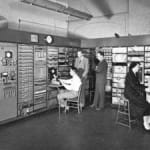Category: Computers
TRADIC
IBM 650
Excerpt from an IBM press release, 1954 | http://www-1.ibm.com/ibm/history/ Called the IBM Magnetic Drum Data Processing Machine, it combines one of the advanced memory devices and the stored program concept of IBM’s big “701, recently announced with new high speed reading capacity in the conventional punched card equipment to achieve…
Regency TR-1
Regency Electronics produced the first commercial transistor radio, the Regency TR-1, it hit the consumer market in October, 1954. It featured four germanium transistors operating on a 22.5-volt battery that provided over twenty hours of life (tube radios with batteries only lasted several hours at best-ref). Several colors were initially…
IBM 701
Whirlwind Computer
Lyons Electronic Office (LEO)
England’s first commercial computer, the Lyons Electronic Office, solved clerical problems. The president of Lyons Tea Co. had the computer, modeled after the EDSAC, built to solve the problem of daily scheduling production and delivery of cakes to the Lyons tea shops. After the success of the first LEO, Lyons…
SWAC
SEAC
The beginning of image processing and the construction of the early National Bureau of Standards Electronic Automatic Computer (SEAC) computer made possible the experiments that led to image processing. SEAC was the first electronic computer with an internally stored program in the United States government. It was the first of…
CSIRAC
The CSIRAC was Australia’s first digital computer and the fifth stored-program machine in the world. It’s first test was run in November, 1949 and it was built by a team of engineers and scientists led by Trevor Pearcey and Maston Beard. Input was done on punched paper tape instead of…
TRADIC
IBM 650
Excerpt from an IBM press release, 1954 | http://www-1.ibm.com/ibm/history/ Called the IBM Magnetic Drum Data Processing Machine, it combines one of the advanced memory devices and the stored program concept of IBM’s big “701, recently announced with new high speed reading capacity in the conventional punched card equipment to achieve…
Regency TR-1
Regency Electronics produced the first commercial transistor radio, the Regency TR-1, it hit the consumer market in October, 1954. It featured four germanium transistors operating on a 22.5-volt battery that provided over twenty hours of life (tube radios with batteries only lasted several hours at best-ref). Several colors were initially…
IBM 701
Whirlwind Computer
Lyons Electronic Office (LEO)
England’s first commercial computer, the Lyons Electronic Office, solved clerical problems. The president of Lyons Tea Co. had the computer, modeled after the EDSAC, built to solve the problem of daily scheduling production and delivery of cakes to the Lyons tea shops. After the success of the first LEO, Lyons…
SWAC
SEAC
The beginning of image processing and the construction of the early National Bureau of Standards Electronic Automatic Computer (SEAC) computer made possible the experiments that led to image processing. SEAC was the first electronic computer with an internally stored program in the United States government. It was the first of…
CSIRAC
The CSIRAC was Australia’s first digital computer and the fifth stored-program machine in the world. It’s first test was run in November, 1949 and it was built by a team of engineers and scientists led by Trevor Pearcey and Maston Beard. Input was done on punched paper tape instead of…

